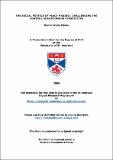Files in this item
The social poetics of place making : challenging the control/dichotomous perspective
Item metadata
| dc.contributor.advisor | Beech, Nic | |
| dc.contributor.author | Clarke, Daniel Wade | |
| dc.coverage.spatial | 256 | en |
| dc.date.accessioned | 2009-05-18T15:17:16Z | |
| dc.date.available | 2009-05-18T15:17:16Z | |
| dc.date.issued | 2008-11-27 | |
| dc.identifier.uri | https://hdl.handle.net/10023/691 | |
| dc.description.abstract | Grappling with the success of their business ventures and coping with the rise in number of new products FifeX was working on, operating out of their shared office in the St Andrews Technology Centre, the co-founders were feeling more ‘cramped’ than ever before. The decision was made to relocate. Although it was felt to be long overdue, much to their relief they finally moved to larger premises in Tayport in July, 2006. The activity of moving was a starting point for a number of place making activities. Using the case of FifeX, this thesis explores the process of place making. It seeks to understand place making from ‘inside’ the activity of place making itself. The guiding research question in this thesis is, what happens -during place making- when people move into ‘new’ business premises? More specifically, this thesis asks the following questions: (i) what are the comparative advantages / disadvantages of the alternative ways of explaining place making? and (ii) which theory or combination of theories, has greater explanatory value in analysing place making / moving? The study, which uses FifeX as an empirical setting is best described as an in-depth qualitative narrative exploration, and thus narrates the unfolding processes of deciding to relocate, relocating, moving and place making. Three different theoretical perspectives (control, engagement, polyphony) were applied, each in turn, to three separate (yet interrelated) instances of place making (a story about a wall, one about chairs, and one about a worktop) in order to cast fresh light on the constitutive talk-entwined-activities of place making. The study demonstrates that although efforts to control space may dominate the discourse and activities of place making, control only explains some of what happens during place making. The findings of the case suggest that place is the outcome of inhabitants’ ongoing experiences and understanding. This thesis argues that alternative theoretical perspectives (engagement and polyphony) are better at explaining what goes on. But because they do not operate ‘naturally’ within the dominant paradigm, it is noted that an alternative practice-based perspective is needed which combines the effectiveness of engagement and polyphony, with the attractiveness of control. A model is presented to help reflect on place making which provides an alternative route for thinking about relocating, moving, and place making that is expected to create engagement and polyphony in a decent way. The proposed model is centred on thinking directed toward: (i) individual place, (ii) inside space, and (iii) what story(s) the space tell outsiders. The focus is on balancing the tensions that emerge from dialoging on these three aspects of space and place. | en |
| dc.format.extent | 3048503 bytes | |
| dc.format.mimetype | application/pdf | |
| dc.language.iso | en | en |
| dc.publisher | University of St Andrews | |
| dc.rights | Creative Commons Attribution-NonCommercial-NoDerivs 3.0 Unported | |
| dc.rights.uri | http://creativecommons.org/licenses/by-nc-nd/3.0/ | |
| dc.subject | Place making | en |
| dc.subject | Decision making | en |
| dc.subject | Relocating | en |
| dc.subject | SMEs | en |
| dc.subject | Ethnography | en |
| dc.subject | Narrative | en |
| dc.subject | Drawing on exprience / participant-produced drawing / activities of artistic creation | en |
| dc.subject | Understanding experience from within | en |
| dc.title | The social poetics of place making : challenging the control/dichotomous perspective | en |
| dc.type | Thesis | en |
| dc.type.qualificationlevel | Doctoral | en |
| dc.type.qualificationname | PhD Doctor of Philosophy | en |
| dc.publisher.institution | The University of St Andrews | en |
This item appears in the following Collection(s)
Except where otherwise noted within the work, this item's licence for re-use is described as Creative Commons Attribution-NonCommercial-NoDerivs 3.0 Unported
Items in the St Andrews Research Repository are protected by copyright, with all rights reserved, unless otherwise indicated.


